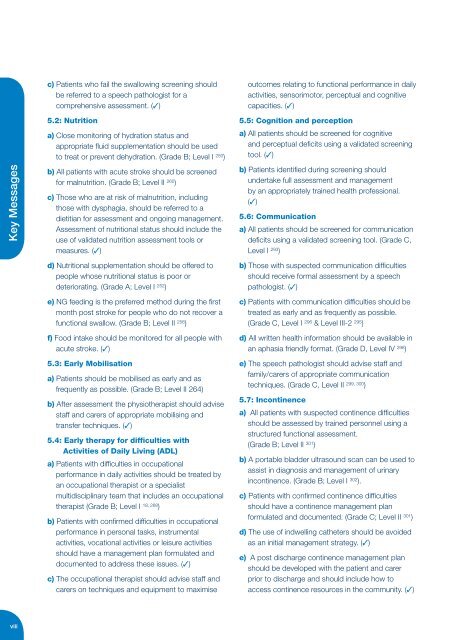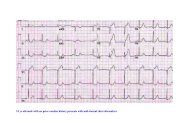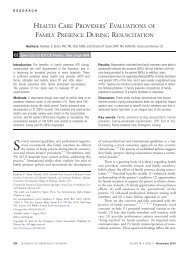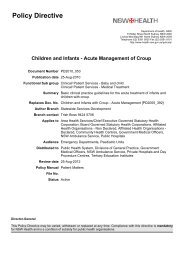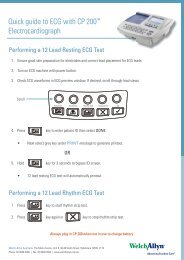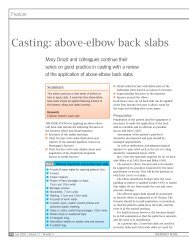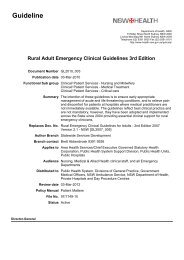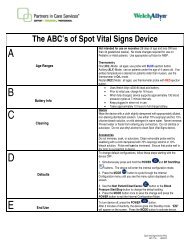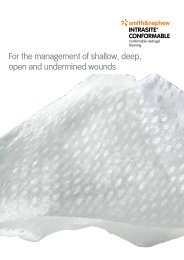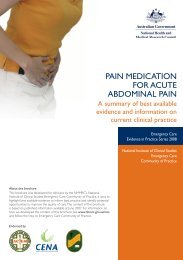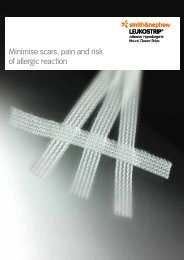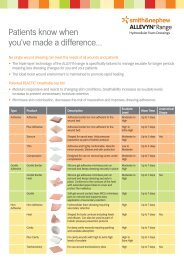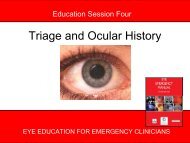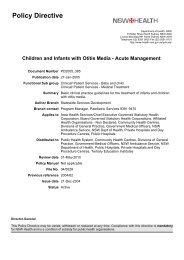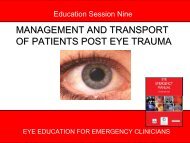Clinical Guidelines for Acute Stroke Management - Living on the EDge
Clinical Guidelines for Acute Stroke Management - Living on the EDge
Clinical Guidelines for Acute Stroke Management - Living on the EDge
You also want an ePaper? Increase the reach of your titles
YUMPU automatically turns print PDFs into web optimized ePapers that Google loves.
Key Messages<br />
c) Patients who fail <strong>the</strong> swallowing screening should<br />
be referred to a speech pathologist <str<strong>on</strong>g>for</str<strong>on</strong>g> a<br />
comprehensive assessment. (✓)<br />
5.2: Nutriti<strong>on</strong><br />
a) Close m<strong>on</strong>itoring of hydrati<strong>on</strong> status and<br />
appropriate fluid supplementati<strong>on</strong> should be used<br />
to treat or prevent dehydrati<strong>on</strong>. (Grade B; Level I 250 )<br />
b) All patients with acute stroke should be screened<br />
<str<strong>on</strong>g>for</str<strong>on</strong>g> malnutriti<strong>on</strong>. (Grade B; Level II 260 )<br />
c) Those who are at risk of malnutriti<strong>on</strong>, including<br />
those with dysphagia, should be referred to a<br />
dietitian <str<strong>on</strong>g>for</str<strong>on</strong>g> assessment and <strong>on</strong>going management.<br />
Assessment of nutriti<strong>on</strong>al status should include <strong>the</strong><br />
use of validated nutriti<strong>on</strong> assessment tools or<br />
measures. (✓)<br />
d) Nutriti<strong>on</strong>al supplementati<strong>on</strong> should be offered to<br />
people whose nutriti<strong>on</strong>al status is poor or<br />
deteriorating. (Grade A; Level I 252 )<br />
e) NG feeding is <strong>the</strong> preferred method during <strong>the</strong> first<br />
m<strong>on</strong>th post stroke <str<strong>on</strong>g>for</str<strong>on</strong>g> people who do not recover a<br />
functi<strong>on</strong>al swallow. (Grade B; Level II 256 )<br />
f) Food intake should be m<strong>on</strong>itored <str<strong>on</strong>g>for</str<strong>on</strong>g> all people with<br />
acute stroke. (✓)<br />
5.3: Early Mobilisati<strong>on</strong><br />
a) Patients should be mobilised as early and as<br />
frequently as possible. (Grade B; Level II 264)<br />
b) After assessment <strong>the</strong> physio<strong>the</strong>rapist should advise<br />
staff and carers of appropriate mobilising and<br />
transfer techniques. (✓)<br />
5.4: Early <strong>the</strong>rapy <str<strong>on</strong>g>for</str<strong>on</strong>g> difficulties with<br />
Activities of Daily <str<strong>on</strong>g>Living</str<strong>on</strong>g> (ADL)<br />
a) Patients with difficulties in occupati<strong>on</strong>al<br />
per<str<strong>on</strong>g>for</str<strong>on</strong>g>mance in daily activities should be treated by<br />
an occupati<strong>on</strong>al <strong>the</strong>rapist or a specialist<br />
multidisciplinary team that includes an occupati<strong>on</strong>al<br />
<strong>the</strong>rapist (Grade B; Level I 18, 268 )<br />
b) Patients with c<strong>on</strong>firmed difficulties in occupati<strong>on</strong>al<br />
per<str<strong>on</strong>g>for</str<strong>on</strong>g>mance in pers<strong>on</strong>al tasks, instrumental<br />
activities, vocati<strong>on</strong>al activities or leisure activities<br />
should have a management plan <str<strong>on</strong>g>for</str<strong>on</strong>g>mulated and<br />
documented to address <strong>the</strong>se issues. (✓)<br />
c) The occupati<strong>on</strong>al <strong>the</strong>rapist should advise staff and<br />
carers <strong>on</strong> techniques and equipment to maximise<br />
outcomes relating to functi<strong>on</strong>al per<str<strong>on</strong>g>for</str<strong>on</strong>g>mance in daily<br />
activities, sensorimotor, perceptual and cognitive<br />
capacities. (✓)<br />
5.5: Cogniti<strong>on</strong> and percepti<strong>on</strong><br />
a) All patients should be screened <str<strong>on</strong>g>for</str<strong>on</strong>g> cognitive<br />
and perceptual deficits using a validated screening<br />
tool. (✓)<br />
b) Patients identified during screening should<br />
undertake full assessment and management<br />
by an appropriately trained health professi<strong>on</strong>al.<br />
(✓)<br />
5.6: Communicati<strong>on</strong><br />
a) All patients should be screened <str<strong>on</strong>g>for</str<strong>on</strong>g> communicati<strong>on</strong><br />
deficits using a validated screening tool. (Grade C,<br />
Level I 293 )<br />
b) Those with suspected communicati<strong>on</strong> difficulties<br />
should receive <str<strong>on</strong>g>for</str<strong>on</strong>g>mal assessment by a speech<br />
pathologist. (✓)<br />
c) Patients with communicati<strong>on</strong> difficulties should be<br />
treated as early and as frequently as possible.<br />
(Grade C, Level I 296 & Level III-2 295 )<br />
d) All written health in<str<strong>on</strong>g>for</str<strong>on</strong>g>mati<strong>on</strong> should be available in<br />
an aphasia friendly <str<strong>on</strong>g>for</str<strong>on</strong>g>mat. (Grade D, Level IV 298 )<br />
e) The speech pathologist should advise staff and<br />
family/carers of appropriate communicati<strong>on</strong><br />
techniques. (Grade C, Level II 299, 300 )<br />
5.7: Inc<strong>on</strong>tinence<br />
a) All patients with suspected c<strong>on</strong>tinence difficulties<br />
should be assessed by trained pers<strong>on</strong>nel using a<br />
structured functi<strong>on</strong>al assessment.<br />
(Grade B; Level II 301 )<br />
b) A portable bladder ultrasound scan can be used to<br />
assist in diagnosis and management of urinary<br />
inc<strong>on</strong>tinence. (Grade B; Level I 302 ).<br />
c) Patients with c<strong>on</strong>firmed c<strong>on</strong>tinence difficulties<br />
should have a c<strong>on</strong>tinence management plan<br />
<str<strong>on</strong>g>for</str<strong>on</strong>g>mulated and documented. (Grade C; Level II 301 )<br />
d) The use of indwelling ca<strong>the</strong>ters should be avoided<br />
as an initial management strategy. (✓)<br />
e) A post discharge c<strong>on</strong>tinence management plan<br />
should be developed with <strong>the</strong> patient and carer<br />
prior to discharge and should include how to<br />
access c<strong>on</strong>tinence resources in <strong>the</strong> community. (✓)<br />
viii


